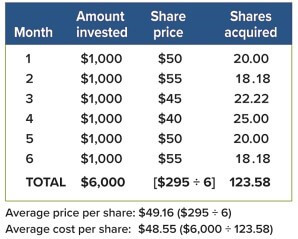After the wild ride of 2020, the U.S. stock market was relatively calm in 2021, but there was still plenty of volatility. There were 55 days when the S&P 500 index — generally considered representative of U.S. stocks — closed with a rise or fall of 1% or more from the previous day’s closing price. And there were seven days with a change of more than 2%.1
The good news for investors is that the trend was generally upward, and the S&P 500 ended the year up almost 27%.2 But no matter which way the market is moving, trying to choose the “right” time to buy or sell can be stressful and counterproductive.
An investor who waits to buy may be frustrated as prices rise and then decide to stop waiting and purchase securities just before prices drop. On the other hand, an investor who sells when prices are dropping may lock in losses and miss out on gains when the market turns upward again. That’s why one of the most fundamental maxims of investing is “you can’t time the market.”
One approach that might help steady your blood pressure and build your portfolio over time is dollar-cost averaging.
A Consistent Strategy
Dollar-cost averaging involves investing a fixed amount on a regular basis, regardless of share prices and market conditions. Theoretically, when the share price falls, you would purchase more shares for the same fixed investment. This may provide a greater opportunity to benefit when share prices rise and could result in a lower average cost per share over time.
If you are investing in a workplace retirement plan through regular payroll deductions, you are already practicing dollar-cost averaging. If you want to follow this strategy outside of the workplace, you may be able to set up automatic contributions to an IRA or other investment account. Or you could make manual investments on a regular basis, perhaps choosing a specific day of the month.
You might also use a similar approach when shifting funds among investments. For example, let’s say you want to shift a certain percentage of your stock investments to more conservative fixed-income investments as you approach retirement. You could execute this in a series of regular transactions over a period of months or years, regardless of market movements.
Steady Investments
If Tina invested $6,000 in a security with a $50 share price in month one, she could purchase 120 shares. If instead she invested $1,000 each month over a six-month period, she might be able to accumulate more shares for the same dollar investment, which could result in a lower average cost per share.

This hypothetical example is based on mathematical principles and used for illustrative purposes only; it does not represent the performance of any specific investment. Actual results will vary.
Dollar-cost averaging does not ensure a profit or prevent a loss, and it involves continuous investments in securities regardless of fluctuating prices. You should consider your financial ability to continue making purchases during periods of low and high price levels. However, dollar-cost averaging can be an effective way to accumulate shares to help meet long-term goals.
Asset allocation is a method used to help manage investment risk; it does not guarantee a profit or protect against investment loss. All investments are subject to market fluctuation, risk, and loss of principal. When sold, they may be worth more or less than their original cost.
1–2) S&P Dow Jones Indices, S&P 500 index for the period 12/31/2020 to 12/31/2021. Retrieved from FRED, Federal Reserve Bank of St. Louis. The S&P 500 is an unmanaged group of securities that is considered to be representative of the U.S. stock market in general. The performance of an unmanaged index is not indicative of the performance of any specific investment. Individuals cannot invest directly in an index. Past performance is not a guarantee of future results. Actual results will vary.
Copyright 2006- Broadridge Investor Communication Solutions, Inc. All rights reserved.
Broadridge Investor Communication Solutions, Inc. does not provide investment, tax, or legal advice. The information presented here is not specific to any individual’s personal circumstances.
To the extent that this material concerns tax matters, it is not intended or written to be used, and cannot be used, by a taxpayer for the purpose of avoiding penalties that may be imposed by law. Each taxpayer should seek independent advice from a tax professional based on his or her individual circumstances.
These materials are provided for general information and educational purposes based upon publicly available information from sources believed to be reliable—we cannot assure the accuracy or completeness of these materials. The information in these materials may change at any time and without notice.
*Non-deposit investment products and services are offered through CUSO Financial Services, L.P. (“CFS”), a registered broker-dealer (Member FINRA / SIPC) and SEC Registered Investment Advisor. Products offered through CFS: are not NCUA/NCUSIF or otherwise federally insured, are not guarantees or obligations of the credit union, and may involve investment risk including possible loss of principal. Investment Representatives are registered through CFS. Coastal Federal Credit Union has contracted with CFS to make non-deposit investment products and services available to credit union members.
CFS representatives do not provide tax or legal guidance. For such guidance please consult with a qualified professional. Information shown is for general illustration purposes and does not predict or depict the performance of any investment or strategy. Past performance does not guarantee future results.
Trust Services are available through MEMBERS Trust Company. CFS* is not affiliated with Members Trust Company.






